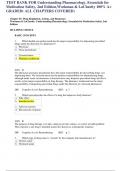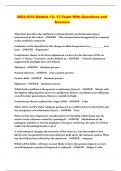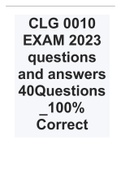-
1. Exam (elaborations) - Test bank for medical-surgical nursing critical thinking in client care, 4th edition ...
-
2. Exam (elaborations) - Ati teas 7 test bank350 questions andanswers 2022
-
3. Exam (elaborations) - Nclex rn complete test bank with more than 850 questions complete with all the correc...
-
4. Exam (elaborations) - Rosenthal lehne’s pharmacotherapeutics for advanced practice providers 2nd edition ...
-
5. Exam (elaborations) - Rosenthal lehne’s pharmacotherapeutics for advanced practice providers 1st edition...
-
6. Exam (elaborations) - Test bank for introduction to maternity and pediatric nursing 9th edition by gloria l...
-
7. Exam (elaborations) - Est bank for canadian fundamentals of nursing, 6th edition test bank for canadian fun...
-
8. Exam (elaborations) - Seidel's guide to physical examination 9th edition ball test bank / ball: seidel’s ...
-
9. Exam (elaborations) - Ati pharmacology proctored exam test bank(1) over 100+ updated 2022 every answer expl...
-
10. Exam (elaborations) - Rn ati concept-based assessment, proctored exam for level 1 test bank.
-
11. Exam (elaborations) - Test bank for medical surgical nursing 7th edition by linton_complete a+ guide (quest...
-
12. Exam (elaborations) - Seidel's guide to physical examination 9th edition ball test bank ball seidel’s gu...
-
13. Exam (elaborations) - Nclex rn actual exam test bank of real questions & answers nclex 2023nclex rn actual ...
-
14. Exam (elaborations) - Test bank - introduction to maternity and pediatric nursing 7e latest updated 2023
-
15. Exam (elaborations) - Test bank - introduction to maternity and pediatric nursing 7e latest updated 2023
-
16. Exam (elaborations) - Ati community health proctored exam test bank (latest-2023
-
17. Exam (elaborations) - Portage learning biod 151 anatomy and physiology 1 all exams (module 1 - module 7) te...
-
18. Exam (elaborations) - Exit hesi test bank (over 1000 q's and answers ) spring 2023 exit hesi prep distinct...
-
19. Exam (elaborations) - Prehospital emergency care, 11e (mistovich et al.) test bank complete questions and ...
-
20. Exam (elaborations) - Ati med surg proctored exam test bank latest 2023 brand new questions included 100% v...
-
21. Exam (elaborations) - Ati maternal newborn proctored exam test bank 2022/2023 a nurse is caring for a clien...
-
22. Exam (elaborations) - Ati rn pharmacology proctored exam test bank 2022-2023 (complete)
-
23. Exam (elaborations) - All hesi exit questions and answers test bank; a+ rated guide (2022) latest update
-
24. Exam (elaborations) - (complete 2022) test bank for seidel's guide to physical examination an interprofessi...
-
25. Exam (elaborations) - Seidel's guide to physical examination 9th edition ball test bank ball seidel’s gui...
-
26. Exam (elaborations) - Hesi exit exam 2023-2024 test bank latest updade
-
27. Exam (elaborations) - Nclex rn actual exam test bank of real questions & answers nclex 2022-2023
-
28. Exam (elaborations) - Test bank - introduction to maternity and pediatric nursing 7e latest updated 2023tes...
-
29. Exam (elaborations) - Hesi mental health rn random from all v1-v3 2023 test banks (all together- various te...
-
30. Exam (elaborations) - Ati nursing care of children proctored testbank exam 2023.docx
-
31. Exam (elaborations) - Ati rn medsurg 2023 proctored exam test bank
-
32. Exam (elaborations) - (complete answered) test bank pharmacology a patient-centered nursing process approac...
-
33. Exam (elaborations) - Test bank for maternal child nursing care 7th edition by shannon e. perry, marilyn j....
-
34. Exam (elaborations) - Test bank for understanding pharmacology, essentials for medication safety, 2nd editi...
-
35. Exam (elaborations) - Solved] hesi critical care test bank rn 2022-2023
-
36. Exam (elaborations) - (complete 275 q&a) med-surg ii hesi test bank 2022-2023
-
37. Exam (elaborations) - Test bank; tncc full solution pack (all tncc exams and study questions are here, all ...
-
38. Exam (elaborations) - (complete) ati rn leadership proctored exam 2019 version 1, 2,3,4,5 & 6 (420 question...
-
39. Exam (elaborations) - Nsg 6005 adv pharm final exam test bank latest 2023
-
40. Exam (elaborations) - Testbank for foundations of maternity, somens health,and child health nursing materna...
-
41. Exam (elaborations) - Hesi mental health rn questions and answers from v1-v3 test banks and actual exams (l...
-
42. Exam (elaborations) - Test bank for advanced assessment interpreting findings and formulating differential ...
-
43. Exam (elaborations) - Test bank for nursing research methods and critical appraisal for evidence-based prac...
-
44. Exam (elaborations) - Complete) ati rn leadership proctored exam 2019 version 1, 2,3,4,5 & 6 (420 questions...
-
45. Exam (elaborations) - Essentials of pediatric nursing 4th edition kyle carman test bank ( all chapters cove...
-
46. Exam (elaborations) - Nur2407 health assesment answered test bank 2023 graded a+
-
47. Exam (elaborations) - Hesi critical care 2023 100%, graded a+ test bank rn
-
48. Exam (elaborations) - Ati med surg test banks graded a+ latest updated september 2023
-
49. Exam (elaborations) - Ati-pn-pharmacology-proctored-exam-test-bank-2023-2024-45
-
50. Exam (elaborations) - Stuvia_1269601_testbank_for_lewis_medical_surgical_nursing_11th_edition_by_harding_al...
-
51. Exam (elaborations) - Testbank-perry-maternal-child-nursing-care-6th-2017-pdf-1
-
52. Exam (elaborations) - Burns' pediatric primary care 7th edition test bank latest updated 2023 burns' pediat...
-
53. Exam (elaborations) - Test bank for bates' guide to physical examination and history taking 15th edition ...
-
54. Exam (elaborations) - Bio 251 quiz testbank latest updated 2023 1. the primary care np sees a patient co...
-
55. Exam (elaborations) - Hesi testbank latest updated 2023 1) a nurse is caring for a client with hyperparath...
-
56. Exam (elaborations) - Test bank for canadian fundamentals of nursing, 6th edition test bank for canadian fu...
-
57. Exam (elaborations) - Applied pathophysiology for the advanced practice nurse 1st edition dlugasch story te...
-
58. Exam (elaborations) - Stahls essential psychopharmacology 5th edition test bank. stahl's essential psychoph...
-
59. Exam (elaborations) - Test bank for psychotherapy for the advanced practice psychiatric nurse a how-to gui...
-
60. Exam (elaborations) - Test bank for psychotherapy for the advanced practice psychiatric nurse: a how-to gui...
-
61. Exam (elaborations) - Test bank for fundamentals of nursing 11th edition potter perry chapter 1-50 complete...
-
62. Exam (elaborations) - Test bank pharmacology a patient-centered nursing process approach, 11th edition by l...
-
63. Exam (elaborations) - Testbank for maternal child nursing care 7th edition by shannon e. perry, marilyn j. ...
-
64. Exam (elaborations) - Timby's introductory medical-surgical nursing 13th edition moreno test bank guide lat...
-
65. Exam (elaborations) - (complete) ati rn leadership proctored exam 2019 version 1, 2,3,4,5 & 6 (420 question...
-
66. Exam (elaborations) - . pn hesi exit exam 2023 version 1, 2, 3 test bank question with answers latest updat...
-
67. Exam (elaborations) - Hesi health assessment latest 2023 test bank real exam 200+questions and detailed ans...
-
68. Exam (elaborations) - Med-surg ii hesi test bank 2023, all answers verified {100% correct} hesi med-surg te...
-
69. Exam (elaborations) - Ati rn concept based assessment level 1 proctored exam for level 1 test bank 2023 100...
-
70. Exam (elaborations) - 2023 critical care hesi exit version 2 (v2) test bank guide - next gen format - a all...
-
71. Exam (elaborations) - All hesi exit questions and answers test bank; a+ rated guide (2023) already graded a...
-
72. Exam (elaborations) - Foundations_of_nursing_9th_edition_cooper_test_bank_3amuzd__1_.pdf (1)
-
73. Exam (elaborations) - (complete) ati rn leadership proctored exam 2019 version 1, 2,3,4,5 & 6 (420questions...
-
74. Exam (elaborations) - Ati rn leadership proctored test bank 400 questions and correct answers/leadership at...
-
75. Exam (elaborations) - Ati rn vati comprehensive predictor 2023 test bank vati rn comprehensive predictor t...
-
76. Exam (elaborations) - Ati mental health proctored test bank 2023 questions and correct answers and rational...
-
77. Exam (elaborations) - Ati teas 7 test bank latest update all subjects 36 different versions exams done in 2...
-
78. Exam (elaborations) - 2023 pediatric (peds) hesi exit version 1 (v1) test bank: next-gen format (all 55 que...
-
79. Exam (elaborations) - Relias medical surgical telemetry exam 2024 test bank complete 180 questions and corr...
-
80. Exam (elaborations) - Relias medical surgical telemetry exam 2024 test bank complete 180 questions and corr...
-
81. Exam (elaborations) - Tncc test bank comprises all versions of the exam,study guides,reviews and all editio...
-
82. Exam (elaborations) - Tncc test 2023-2024 actual final exam test bank 300 questions and corret detailed ans...
-
83. Exam (elaborations) - Tncc 9th real exam actual verified exam test bank 50 questions and answers verified a...
-
84. Exam (elaborations) - Tncc 9th real exam actual verified exam test bank | includes 3 tested versions of the...
-
85. Exam (elaborations) - Apea predictor exam 2023-2024 test bank 300+ questions and correct answers with ratio...
-
86. Exam (elaborations) - Ati teas 7 science testbank with answers
-
87. Exam (elaborations) - Exit hesi practice questions and answers test bank a+ rated guide (2024)
-
88. Exam (elaborations) - Hesi rn exit exam questions and answers test bank a+ rated guide (2024)
-
89. Exam (elaborations) - Hesi rn exit exam questions and answers test bank a+ rated guide (2024)
-
90. Exam (elaborations) - Bates' nursing guide to physical examination and history taking 10th edition hogan-q...
-
91. Exam (elaborations) - Applied pathophysiology for the advanced practice nurse 10nth edition dlugasch story...
-
92. Exam (elaborations) - Buttaro primary care, a collaborative practice, 9th edition test bank 100% complete g...
-
93. Exam (elaborations) - Anatomy and physiology openstax test bank 2024 |already graded a+
-
94. Exam (elaborations) - Lehne’s pharmacotherapeutics for advanced practice nurses and physician assistants ...
-
95. Exam (elaborations) - Lehne’s pharmacotherapeutics for advanced practice nurses and physician assistants ...
-
96. Exam (elaborations) - Apea predictor exam 2024 test bank 500+ questions and correct answers with rationales...
-
97. Exam (elaborations) - Ati community health proctored 2023 exam test bank 350 questions and correct detailed...
-
98. Exam (elaborations) - Ati community health proctored 2023 exam test bank 350 questions and correct detailed...
-
Show more






